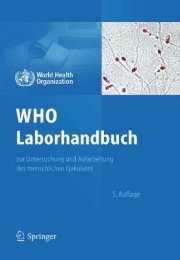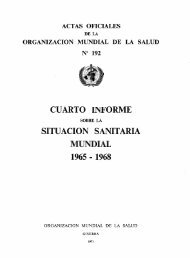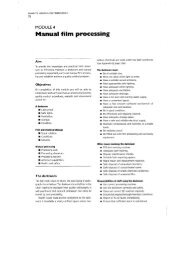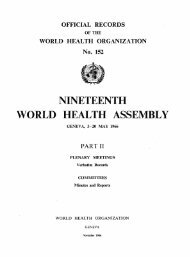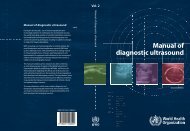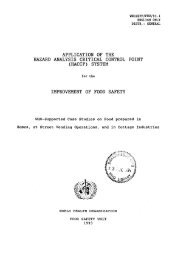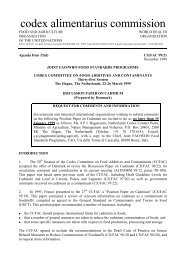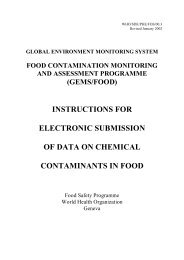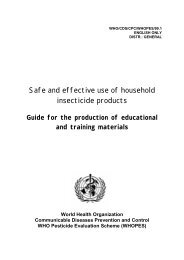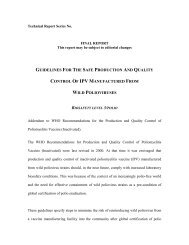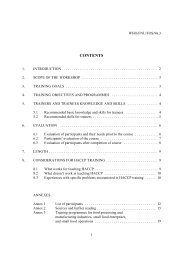WHO Drug Information Vol. 20, No. 4, 2006 - World Health ...
WHO Drug Information Vol. 20, No. 4, 2006 - World Health ...
WHO Drug Information Vol. 20, No. 4, 2006 - World Health ...
You also want an ePaper? Increase the reach of your titles
YUMPU automatically turns print PDFs into web optimized ePapers that Google loves.
Rational Use of Medicines<br />
The study was carried out during the<br />
period <strong>20</strong>00-<strong>20</strong>04. It included patients <strong>20</strong><br />
years and older (since DDDs are based<br />
on adult doses). Patients were grouped in<br />
10-year age groups. <strong>Drug</strong>s were selected<br />
from ATC code group R03 — drugs for<br />
inhalation and oral use (1). This includes:<br />
• R03AC selective beta-2-adrenoreceptor<br />
agonists<br />
• R03AK adrenergics and other drugs for<br />
obstructive airway disease; combination<br />
drugs for inhalation<br />
• R03BA glucocorticoids<br />
• R03BB anticholinergics<br />
• R03C adrenergics for systemic use<br />
• R03D other systemic drugs for obstructive<br />
airway disease.<br />
Only prescriptions with precise posology/<br />
dosing instructions (e.g. one inhalation<br />
twice a day) were included. Consequently,<br />
all prescriptions with instructions<br />
such as “to be used when needed” were<br />
excluded.<br />
For each 10-year age group of patients<br />
and for each ATC-group at the 5th level<br />
(e.g. R03AC02 for salbutamol) the PDD<br />
for each prescription was computed. The<br />
DDD-values for each drug were divided<br />
with the computed PDD value and the<br />
mean DDD/PDD ratio for each substance<br />
and for each 10-year age group was then<br />
calculated. For drugs with less than <strong>20</strong><br />
registered prescriptions over the five year<br />
study period the DDD/PDD ratios were<br />
not determined.<br />
For the period <strong>20</strong>00–<strong>20</strong>04, 1812 patients<br />
<strong>20</strong> years and older were registered in the<br />
pharmacy record data base as having<br />
acquired R03 drugs from pharmacies in<br />
the county. The number of dispensations<br />
was 23 223. The DDD/PDD ratios for the<br />
different drug substances and the different<br />
age groups are presented in Table 1.<br />
262<br />
<strong>WHO</strong> <strong>Drug</strong> <strong>Information</strong> <strong>Vol</strong> <strong>20</strong>, <strong>No</strong>. 4, <strong>20</strong>06<br />
It was possible to calculate the DDD/PDD<br />
ratios for 15 of 18 asthma/COPD drugs.<br />
For three drugs — the short acting<br />
adrenergics salbutamol (R03AC02) and<br />
terbutaline (R03AC03) and the combination<br />
product of salbutamol and ipratropium<br />
(R03AK04) — over 95% were<br />
prescribed to be used “when needed”. <strong>No</strong><br />
DDD/PDD ratios were therefore determined<br />
for these drugs. For the youngest<br />
age group, <strong>20</strong>–29 years, the number of<br />
prescriptions for 9 of the drugs was too<br />
low to make a determination of the DDD/<br />
PDD ratios meaningful.<br />
PDDs were obtained from the pharmacy<br />
record data base of the same county.<br />
Data on R03 drugs from this data base<br />
(11) have previously been determined to<br />
correlate closely with data from the<br />
national register (8). The ratios are likely<br />
to be representative of the current<br />
situation in the rest of Sweden.<br />
The DDD/PDD ratios for most drugs<br />
showed only small variations between the<br />
different age groups. For fluticasone there<br />
was a two-fold variation among the age<br />
groups with higher ratios for young and<br />
elderly patients. The reason for this is not<br />
clear. For ipratropium bromide the ratio<br />
increased by age. It is apparent that<br />
doctors prescribed lower doses of this<br />
anticholinergic drug to older patients,<br />
although no such recommendation is<br />
included in the specifications for the drug<br />
(12).<br />
Of 15 drugs, the mean DDD/PDD ratios<br />
were close to 1 for 10. Two drugs,<br />
formoterol for inhalation and terbutaline<br />
for oral use, had DDD/PDD ratios of 0.7<br />
and 0.6, respectively, showing that 1.4<br />
and 1.6 DDDs were the average prescribed<br />
doses for these drugs. For three<br />
other drugs, fluticasone, ipratropium<br />
bromide, and theophylline the ratios were<br />
1.7, 2.7 and 1.4 respectively, indicating<br />
that the average prescribed dose for



